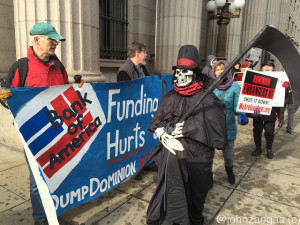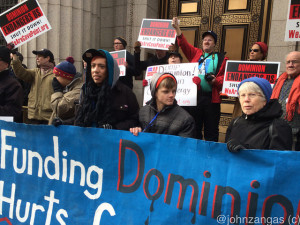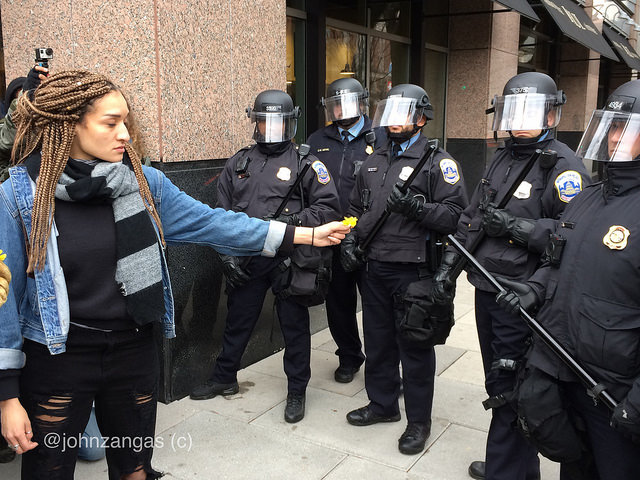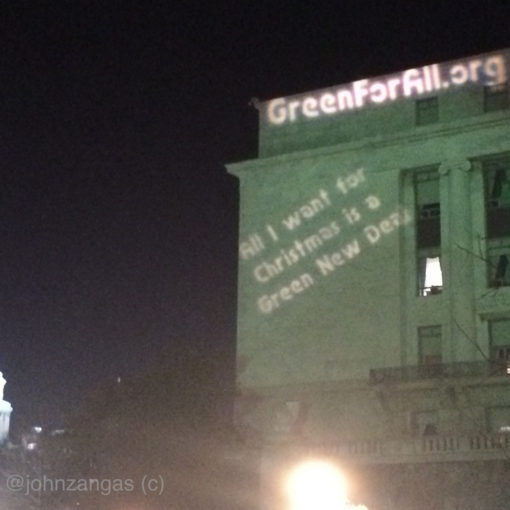
An official at a government agency responsible for permitting gas infrastructure took a potshot at protesters who were disrupting a public meeting on January 21. As Commissioner Tony Clark announced that he was leaving the Federal Energy Regulatory Commission when his term expires, he sniped at what he seemed to think was the demonstrators’ ingratitude for a primary service FERC performs: greasing the wheels for gas companies to build pipelines, storage facilities and compressor stations to fuel the electrical grid.
“I find it rather ironic,” he said, “that just 24 hours before a very major winter storm on the East Coast, we have people protesting the very infrastructure that will keep them alive over the next 72 hours.”
His remark flies in the face of activists and community members who have been persistently streaming into the FERC monthly meetings for more than a year. Feeling ignored during the permitting process and desperate to get their viewpoint across, they have interrupted the proceedings because, unlike Clark, they believe gas infrastructure is life-threatening, not lifesaving.
Betsy Conover from Harrisburg, PA pushed back. “You are wrong,” she responded to Clark. “Fracking gas infrastructure is destroying communities in Pennsylvania, across the commonwealth. It’s destroying the environment. It’s all-around a bad thing.”
“There are alternatives,” she said. “And we’re not talking about alternatives.” Security then escorted her from the meeting room.
Clark implied that FERC-permitted infrastructure delivers gas for power to heat homes. But Carol Cutler of Westmoreland County, PA pointed out that some if not a great deal of new infrastructure will not deliver gas for domestic use.
“The product that’s going to be moved through this [Mariner East] pipeline is not going to be used for public good,” she said. “It’s to fulfill a contract to supply natural gas to Norway to make plastic.” She objects to private companies using eminent domain to take people’s land.
Ashley Tuhro traveled all the way to Washington from Wichita, KS with her two sons to tell FERC commissioners how fracking—a method of extracting gas from shale formations by injecting sand, chemicals and water at high pressure—is affecting the area where she lives.
“We’re having anywhere between three to four earthquakes a week and sometimes more,” Tuhro said. Wastewater injection from oil and gas fracking wells has been linked to earthquakes. “When they first started earthquakes they were 2.1 to 2.5 [on the Richter scale] and now they’re all the way up to 4.6, and that was last week.”
FERC doesn’t regulate fracking wells, but nearly all the new infrastructure which the gas industry wants to build—and FERC must approve–is for the purpose of transporting, storing, and exporting gas produced from fracking.
Tuhro thinks the FERC Commission is out of touch. “I don’t think they really understand what they’re doing,” she said. “They’re causing so much damage. By the time my kids are old enough to have kids, what’s gonna be left?”
FERC announced today that it will initiate investigations of the rates charged by four interstate natural gas pipelines to determine if the companies may be substantially over-recovering their costs, resulting in unjust and unreasonable rates.
 Bank of America Urged to “Dump Dominion”
Bank of America Urged to “Dump Dominion”
Following the FERC meeting, a group of about 25 protesters converged on a Washington, DC branch of Bank of America, calling the institution out for being a major financier of a climate-busting gas export project which endangers a Chesapeake Bay community.
Climate activists have singled out fracked gas export terminals because they produce more greenhouse gas emissions than burning coal. The dangers of liquefying gas to ship in tankers overseas are also great, since the process requires its own power plant with proximity to giant tanks of propane and hazardous chemicals. The Cove Point terminal in Lusby, MD poses a particular threat to the surrounding community, which must breathe 22.5 tons of cancer- and asthma-causing pollutants produced each year, as well as live with the potential of a catastrophic accident.
Members of the coalition group We Are Cove Point delivered a letter to the branch manager addressed to Bank of America CEO Brian Moynihan, urging him to “dump Dominion” by retracting the $4 billion line of credit to parent company Dominion Resources.
The letter emphasized that no other gas liquefaction facility in the world was located in such a densely populated area and asked Moynihan to put himself in the place of Lusby residents. “Could you live with yourself if your family lived in those conditions and didn’t move away, if your children developed illnesses that you knew in advance were likely to occur?”
The branch closed its doors to customers for an hour while protesters outside held a banner reading, “Funding Dominion Hurts Communities #DumpDominion.” A person costumed as the Grim Reaper stalked the sidewalk as others wielded noisemakers and whistles to attract attention.
In November, activists from We Are Cove Point carried out a daring rappel maneuver from the top tier of Bank of America stadium in Charlotte, NC, hanging with a banner directly in front of the press box during Monday Night Football.
Coincidentally, Dominion Resources took a blow on Thursday when the U.S. Forest Service rejected its application for a special permit for the Atlantic Coast Pipeline route through the George Washington and Monongahela National Forests. Creating an alternative route to satisfy the Forest Service and reapplying for the permit will cause a major delay for the 550-mile pipeline project intended to go from West Virginia through Virginia to North Carolina. An offshoot from the Atlantic Coast Pipeline would deliver gas to Cove Point LNG for export.





